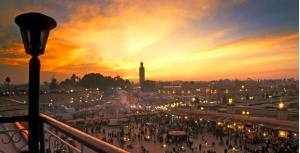The Telegraph – Travel
 An insider’s guide to Marrakesh, Morocco, including expert advice on the best hotels, restaurants, bars, shops and attractions, selected by Alison Bing.
An insider’s guide to Marrakesh, Morocco, including expert advice on the best hotels, restaurants, bars, shops and attractions, selected by Alison Bing.
Why go?
Forget all those bucket-and-spade beach breaks that can be summed up on a postcard… Marrakesh leaves you with holiday photographs that demand further explanation. How did you wind up sipping tea with blacksmiths, shedding your skin – quite literally – in a hammam (bathhouse), and busting Berber dance moves in the Djemaa el-Fna? Sipping a sunset cocktail on the roof of an 18th-century riad, you think back over the day’s experiences and, in your mind, try to retrace your steps. Possibly there was a donkey cart dodged or a magic shop stumbled upon among the city’s 3,000 winding derbs (alleyways), but that doesn’t entirely explain your iron lantern, your henna tattoo and your newfound capacity to shimmy.
When to go?
Marrakech is a true “year round” destination. Spring and autumn sees the city at its best with almost guaranteed sunshine and bearable temperatures (days are warm and nights are not too chilly). At the height of summer, daytime temperatures can reach a sweltering 38 degrees C and shops and restaurants often close during Ramadan in August. Winter can be warm and blissfully free of crowds – but remember that temperatures drop dramatically at night.
Getting there
Transfers: Door-to-door airport transfers are best arranged through your guesthouse or hotel for £12-£18. If you know the way and travel light, taxi hire from the airport costs £10 maximum.
Cruises: Many cruise passengers disembark in Casablanca, where ONCF (00 212 890 20 30 40,http://www.oncf.ma) operates a frequent train service to Marrakesh, departing from Casa Voyageurs station. Journey time is 3hr 30min.
Trains: If you have time to spare, consider the scenic route: Eurostar to Paris, then sleeper train through Spain, ferry to Tangier, and train to Marrakesh via Casablanca. See Seat 61 (http://www.seat61.com/Morocco.htm) for details. Taxis from the train station into Marrakesh charge around £2.
Getting around
Carriages: The best way to get around the Medina is on foot, but shiny green calèches (horse-drawn carriages) are still used for public transport. Your chariot awaits in the Djemaa el-Fna, with brass lanterns and official rate charts (about £7 per hour).
Taxis: These are handy for trips from the Medina to the New City. Meters are often broken, but trips within Marrakesh cost from £75p to £1.50 maximum, plus a 75p night surcharge.
Car hire: Have you seen Marrakesh traffic? Spare yourself the stress, unless you are heading to a remote locale in the mountains or the desert. If you do decide to hire a car, book through major companies such as Hertz (www.hertz.com), National (www.nationalcar.co.uk) and Budget (www.budget.com). A compact car costs from £35 [AP2] per day, a 4WD from £90.
When navigating narrow Medina alleyways, bear in mind unofficial rights of way: 1) anything with hooves; 2) anything on wheels; 3) anyone with a stick; 4) babies; 5) women shopping.
Know before you go
Essential contacts
British Embassy, Rabat: 00 212 537 63 33 33,http://ukinmorocco.fco.gov.uk/en.
British Honorary Consulate Marrakesh: 00 212 524 42 08 46, 55 Boulevard Zerktouni, Gueliz.
Tourist police: 00 212 524 38 46 01.
Ambulance: 00 212 524 43 30 30.
Polyclinique du Sud hospital: 00 212 524 44 79 99.
Tourism Office: 00 212 524 43 61 79, Place Adbdel Moumen ben Ali, Gueliz.
The basics
Currency: Dirham (abbreviated to MAD or Dh).
Telephone code: Dial 00 212 if calling Marrakesh from the UK. From inside Morocco, substitite 00 212 in all the above numbers with 0.
Time difference: +1 hour.
Languages: Darija (Moroccan Arabic), French, Tashelhit (Berber).
Flight time: London to Marrakesh is between 3hr 30min and four hours.
Local laws and etiquette
After nightly antics in the Djemaa el-Fna for 1,000 years, Marrakesh isn’t easily shocked. Still, it’s considered a sign of respect for your hosts to keep knees and shoulders covered. (This goes for men, too.)
Headscarves and skull caps aren’t expected, nor are they judged. In cosmopolitan Marrakesh, it is understood that religious devotion and cultural affiliation cannot be determined by appearances alone.
Gender roles aren’t rigidly defined in Marrakesh, where women play pivotal roles in family and civic life – just ask Mayor Fatima Zohra Mansour.
Some rules do apply, just not to traffic. Mosques and zawiyyas (saint’s shrines) are not open to non-Muslims. Although Marrakesh is broad-minded, Moroccan laws still technically prohibit extramarital sex, drinking in public and smoking kif (hashish). As always in Marrakesh, discretion is advised.
Don’t be embarrassed by consulting maps, or declining unsolicited company. Although Marrakesh has cracked down on professional faux guides (false guides), mischievous children may still try to mislead you. When in doubt, ask directions from the nearest hanout (grocer).
Official guides hired through riads or the tourist office will squire you through the Medina for a price (£16-£20 per half-day) – but doesn’t that defeat the whole purpose of the Marrakesh adventure? Also: souk merchants give better prices when they don’t have to pay a guide’s commission.
.







